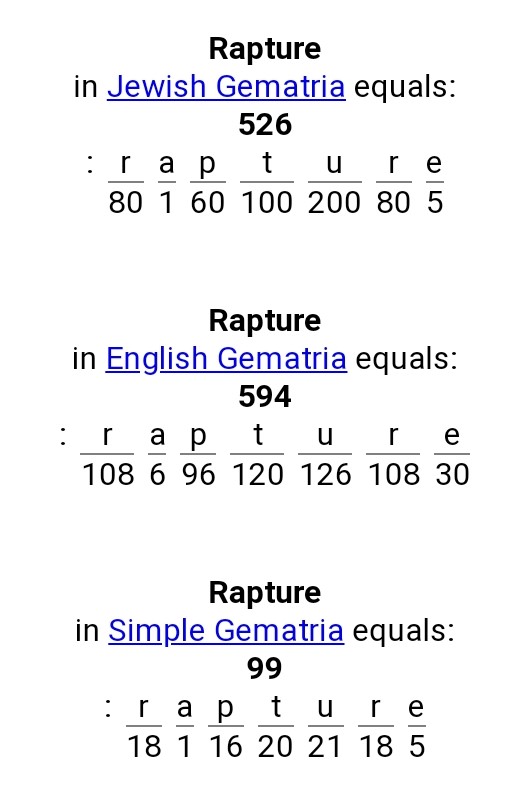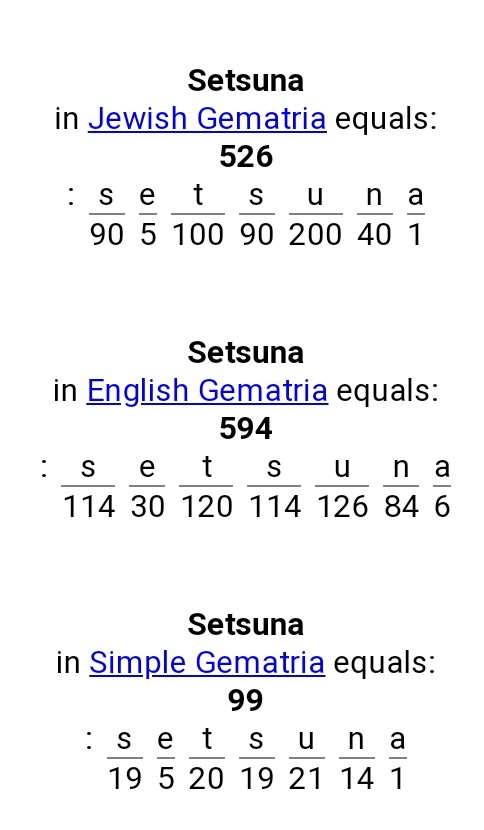イエスキリストを救い主として心から信じた者は、終末期の最後の時、この世から一瞬にして引き上げられる、という描写が聖書にあります。
そのことを ❝携挙(rapture)❞と呼んでいます。
聖書の中に❝携挙(rapture)❞という名詞の単語は存在しませんが、その代わりに ❝一瞬にして天に取り上げられる❞という動詞であるギリシア語 harpazōで表現されています。
今朝、神様から、❝rapture❞という言葉の数字を調べるように促されました。
(PS 今回は、艱難前携挙が間違いであるという話題には触れません。)
以前は見過ごしてしまっていましたが、再度 調べたところ、あることに気付きました!
コチラが、❝rapture❞ の数字です。

そして、❝rapture❞ と同じ3つの数字を持つ言葉を1つだけ見つけました。

一瞬、❝setsuna❞という英語の意味を考えてしまいましたが、英語オリジナルから由来した言葉に ❝tsu❞ が入る単語は存在しません。
自動車メーカー「マツダ」を例にとりますが、英語ではMATSUDAではなく、MAZDAになります。
これって、日本語の「刹那」のことでは?と、気付きました!
setsuna (刹那)は、本来は哲学/宗教から来た用語なので、sezna とは変換されずに、「setsuna」 として使われているようです。ヒンズー教・仏教概念なので、西側の概念には存在しておらず、海外でも そのまま手を加えられず、❝setsuna❞として使われているようです。
気になったので、❝刹那❞という言葉の由来を詳しく調べたところ、raputureと同じく「一瞬」という意味でした。まさかです、3つの一致がありました!
rapture と setsunaともに… 同じ3つの数字を持つ言葉
それだけではなく… どちらも、 ❝瞬間❞という意味
更には… 肉体から魂が離れ 霊になる瞬間 = 天国 /極楽に移る瞬間のこと
驚愕!! (@_@
これら、不思議な一致をどう捉えるべき!?
仏教とキリスト教は、私たちの先入観を超え、ベースの部分で繋がっているのかも知れません。深く研究した人でないと判らない世界ですので、私はあえて まとめません。
ちなみに、この分野の権威は久保氏です。
仏教用語から来た❝刹那❞とは・・・
「一瞬」「瞬間」「瞬く間」「極めて短い時間」「ほんのわずかな時間」「非常に短い時間」という意味。仏典では時間を表す単位として使われていた。本来,仏教/ヒンズー教などで定義されている最小の時間の単位。1つの意識の起こる時間。
語源は古代インドのサンスクリット語の❝ksana (kshana)❞。これを漢字に当てはめると本来の意味は「念」になり、漢字に当てはめると❝刹那❞になる。
>>1回指を弾く間に60あるいは65の刹那があるとされる。その長さについては諸説ある中、「1/75秒」ほどであると言われている。
>>仏教哲学では「刹那」は、物質的、精神的なかんずく精神的な現象の瞬間的生滅を説明するときに使われる。
聖書にある携挙(rapture)の描写:
50兄弟たちよ。わたしはこの事を言っておく。肉と血とは神の国を継ぐことができないし、朽ちるものは朽ちないものを継ぐことがない。 51ここで、あなたがたに奥義を告げよう。わたしたちすべては、眠り続けるのではない。終りのラッパの響きと共に、またたく間に、一瞬にして変えられる。 52というのは、ラッパが響いて、死人は朽ちない者によみがえらされ、わたしたちは変えられるのである。 53なぜなら、この朽ちるものは必ず朽ちないものを着、この死ぬものは必ず死なないものを着ることになるからである。 54この朽ちるものが朽ちないものを着、この死ぬものが死なないものを着るとき、聖書に書いてある言葉が成就するのである。1コリント15:50-54
48 As was the earthly man, so are those who are of the earth; and as is the heavenly man, so also are those who are of heaven. 49 And just as we have borne the image of the earthly man, so shall we bear the image of the heavenly man.
50 I declare to you, brothers and sisters, that flesh and blood cannot inherit the kingdom of God, nor does the perishable inherit the imperishable. 51 Listen, I tell you a mystery: We will not all sleep, but we will all be changed— 52 in a flash, in the twinkling of an eye(瞬きのような短い瞬間), at the last trumpet. For the trumpet will sound, the dead will be raised imperishable, and we will be changed. 53 For the perishable must clothe itself with the imperishable, and the mortal with immortality. 1Corinthians 15:48-54
~~~~~~~~~~~~~~~
【追記】 (英語の原文から抜粋)
ksana(一瞬) について :
ksana(क्षण) は、仏教、パーリ語、ヒンドゥー教、サンスクリット語、マラーティー語、ヒンディー語で存在する概念です。
・kṣaṇa(क्षण) とは、2世紀に書かれた「Mahāprajñāpāramitāśāstra」25章によれば、時間の単位を意味する。 指一本分の時間(acchaṭā-mātra)に60の瞬間(kṣaṇa)があり、それぞれのkṣaṇaで心は生まれ(utpāda)、消滅(bhal_1E45↩ga)する」とある。しかし、それが連続して起こるとき、私たちはこれが欲望の心(rāgacitta)、怒りの心(dveṣacitta)、妄想の心(mohacitta)、信仰の心(prasādacitta)、知恵( prajñā )または快楽( dhyāna )の純粋な心( viśuddhacitta)であると知る。
・kṣaṇa(क्षण) とは、最も短い時間のことである。小乗仏教徒は、ダルマはkṣaṇika、瞬間的であるという点では一致しているが、この諡号の意味については意見が分かれる。過去と未来の存在を認め、kṣaṇikaダルマに条件付きダルマ(saṃskṣa)の2つ、3つ、4つの特徴を認めるパーリ学者とsaṃskṛtadharma-lakṣaṇaは、ダルマは1 kṣaṇaの空間に生じ、耐え、滅するという意見(cf.... Visuddhimagga; Abhidhammaṭṭhasaṃgha; Kośa; Saṃghabhadra)とする。
・指一本分の時間(acchaṭā-mātra)に60の瞬間(kṣaṇa)があり、それぞれのkṣaṇaで心は生まれ(utpāda)、消滅(bhal_1E45↩ga)する」とある。しかし、それが連続して起こるとき、私たちはこれが欲望の心(rāgacitta)、怒りの心(dveṣacitta)、妄想の心(mohacitta)、信仰の心(prasādacitta)、知恵( prajñā )または快楽( dhyāna )の純粋な心( viśuddhacitta)であると知るのです」。
・大乗仏教経典の8章「Gaganagañjaparipṛcchā」によれば、「思考の(瞬間)」のことである。 そして、無条件の不思議な顕現の力によって、仏陀(Ekaratnavyūha)の奇跡的な演技(vikrīḍita)によって、(Gaganagañja と他の菩薩たちは)一瞬の思いで大宇宙からサハー宇宙へテレポートし、そこに腰を下ろした(エカ・シッタ・クルエスターナ:Eka-citta-k_ena)。Visuddhimagga; Abhidhammaṭṭhasaṃgha; Kośa; Saṃghabhadra)とする。
彼らは、大宇宙から花、花輪、粉、香水、化粧品、パラソル、幟 (のぼり) 、旗を雨のように降り注いだ。
kavyaカーヴィヤ(古典詩)にある❝ksana❞についての記述
❝kṣaṇa (क्षण) ❞ は、KālidāsaのRaghuvaṃśa節 8.88-90.According によると「瞬間」を意味する。
「賢者たちは、死は具現化した生き物の自然な状態であり、生はその状態の変化であると言う。もし、ある存在が一瞬でも呼吸を保っているならば、それは確かに幸運である。愚かな人は、大切な人が息を引き取ったことを、彼の心臓に矢が放たれた瞬間のようなものだと考える。別の人は、逆に、彼の心臓から矢が抜かれた瞬間だと見なします。それが幸福への扉だと知っているからです。肉体と魂が一体となっている状態から、最後に分離することを悟る時、どの賢者が感覚の外的対象からの分離によって苦しめられると説くのでしょうか?」。
kavyaカーヴィヤ
サンスクリット古典様式kavyaカーヴィヤは、西暦 200~1200年にかけてインドの宮廷叙事詩に用いられたサンスクリット文語体。隠喩や比喩を駆使した精巧な詩的表現が特徴。
現存する最古のカーヴィヤ文学は、仏教徒のAshvaghosaによって書かれたものである。「釈迦の生涯」と『サウンダラナンダ』(「スンダリとナンダについて」)という、マハーカヴィア風の2作が現存している。アシュヴァーゴサは、韻律の複雑さ、文法や語彙の微妙な使い分けにおいて、ヒンドゥー教のマハーカヴィヤの作家のスタイルを先取りしていた。kavyaは現代のインドの言語と文学に影響を与え続けている。
(原文は以下の英語)
What is ❝kshana❞?
❝kshana❞ means something in Buddhism, Pali, Hinduism, Sanskrit, Marathi, Hindi.
Kṣaṇa (क्षण) refers to a “moment”, according to Kālidāsa’s Raghuvaṃśa verse 8.88-90.—Accordingly: “The wise say that death is the natural state of embodied creatures and life is a change in that state. If a being remains breathing even for a moment (kṣaṇa) it is surely fortunate. The foolish man regards the loss of his dear one as a dart shot into his heart. Another man looks on the same as a dart that has been pulled out, for it is a door to beatitude. When we are taught that our own body and soul unite and then separate, tell me which wise person should be tormented by separation from the external objects of the senses?”.
Kṣaṇa (क्षण, “moment”) refers to a unit of time according to the 2nd century Mahāprajñāpāramitāśāstra (chapter XXV).—Accordingly, “In the time of a finger-snap (acchaṭā-mātra), there are sixty moments (kṣaṇa); in each kṣaṇa, the mind is born (utpāda) and ceases (bhaṅga); but as it arises in a series, we know that this is a mind of desire (rāgacitta), that, a mind of anger (dveṣacitta), or a mind of delusion (mohacitta), a mind of faith (prasādacitta), or a pure mind (viśuddhacitta) of wisdom (prajñā) or rapture (dhyāna)”.
The kṣaṇa, moment, is the shortest time. Buddhists of the Lesser Vehicle agree in saying that Dharmas are kṣaṇika, momentary, but disagree on the meaning of this epithet. Pāli scholars and the Sarvāstivādin-Vaibhāṣikas, who accept the existence of the past and the future and who recognize in the kṣaṇika dharma two, three or four characteristics of the conditioned dharma (saṃskṛtadharma-lakṣaṇa), are of the opinion that the dharma arises, perdures and perishes in the space of one kṣaṇa (cf. Visuddhimagga; Abhidhammaṭṭhasaṃgha; Kośa; Saṃghabhadra).
Ksana expressed in ❝Kavya❞
kavya, highly artificial Sanskrit literary style employed in the court epics of India from the early centuries AD. It evolved an elaborate poetics of figures of speech, among which the metaphor and simile predominate.
Kṣaṇa (क्षण) refers to a “(moment) of thought”, according to the Gaganagañjaparipṛcchā: the eighth chapter of the Mahāsaṃnipāta (a collection of Mahāyāna Buddhist Sūtras).—Accordingly, “[...] Then, by the unconditioned magical power of manifestation, by the miraculous performances (vikrīḍita) of the Buddha [Ekaratnavyūha], [Gaganagañja with the other Bodhisattvas] teleported from the Mahāvyūha universe to the Sahā universe, in one moment of thought (eka-citta-kṣaṇa), and sat down there. They showered flowers, garlands, powders, perfumes, unguents, parasols, banners, flags from the Mahāvyūha universe pouring down as rain”.
そういえば、このような質問もありました…